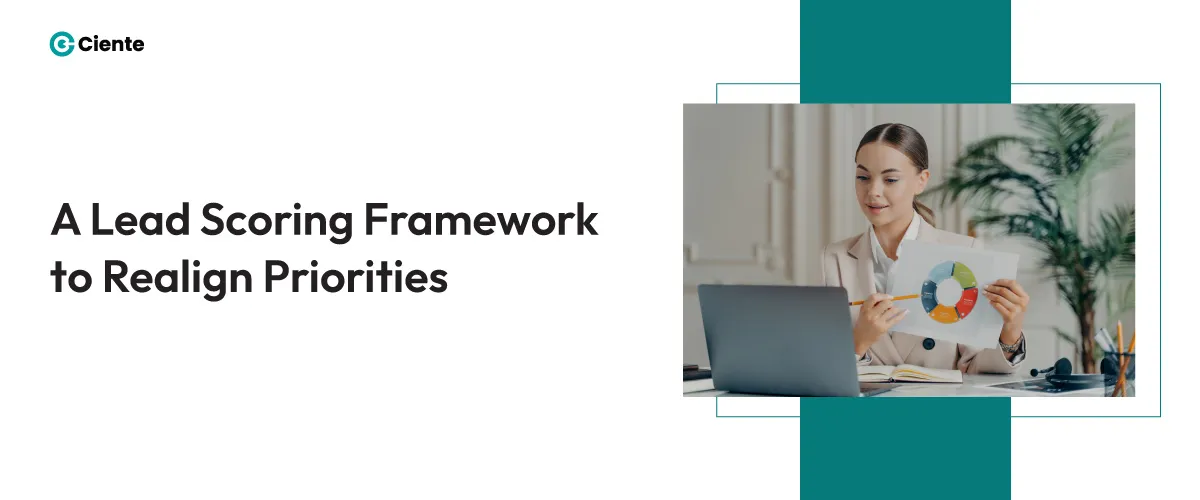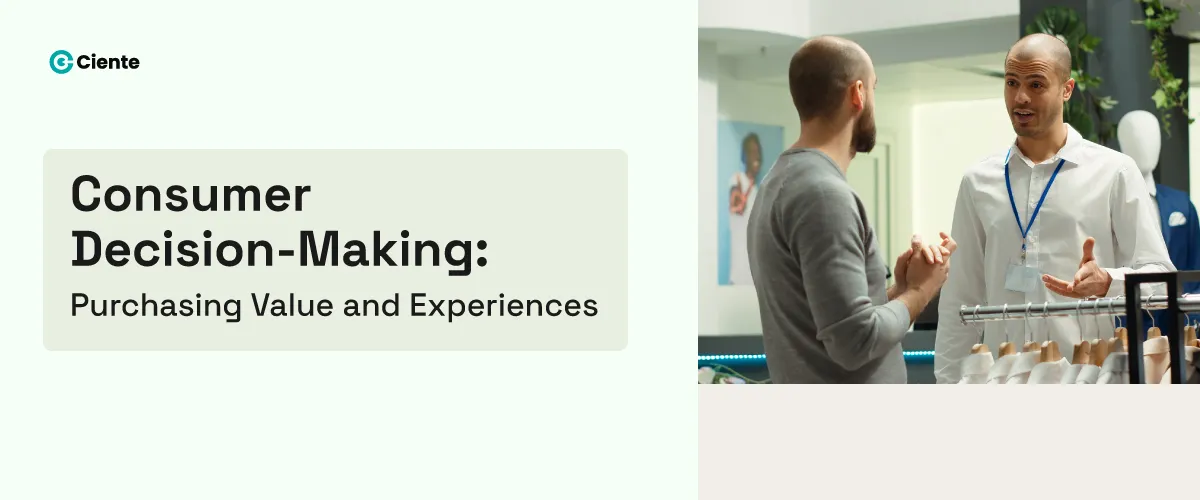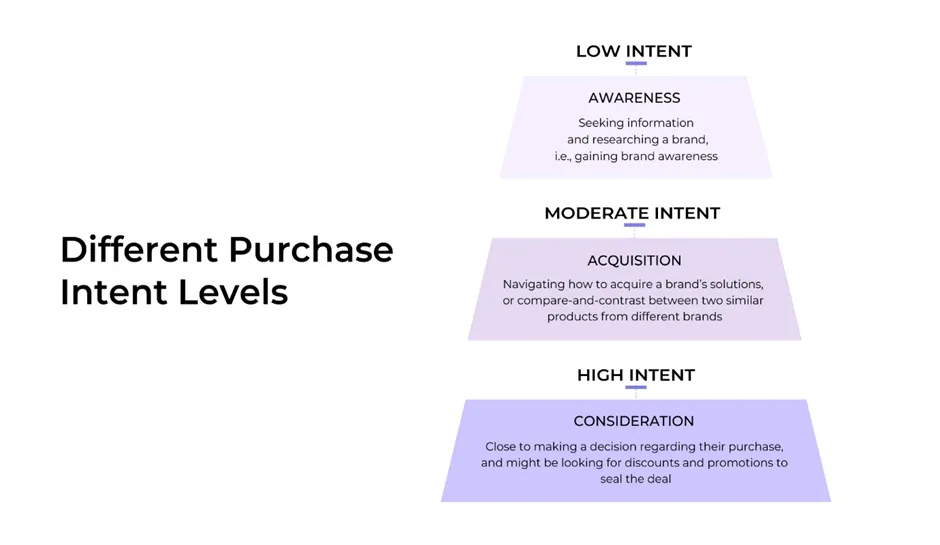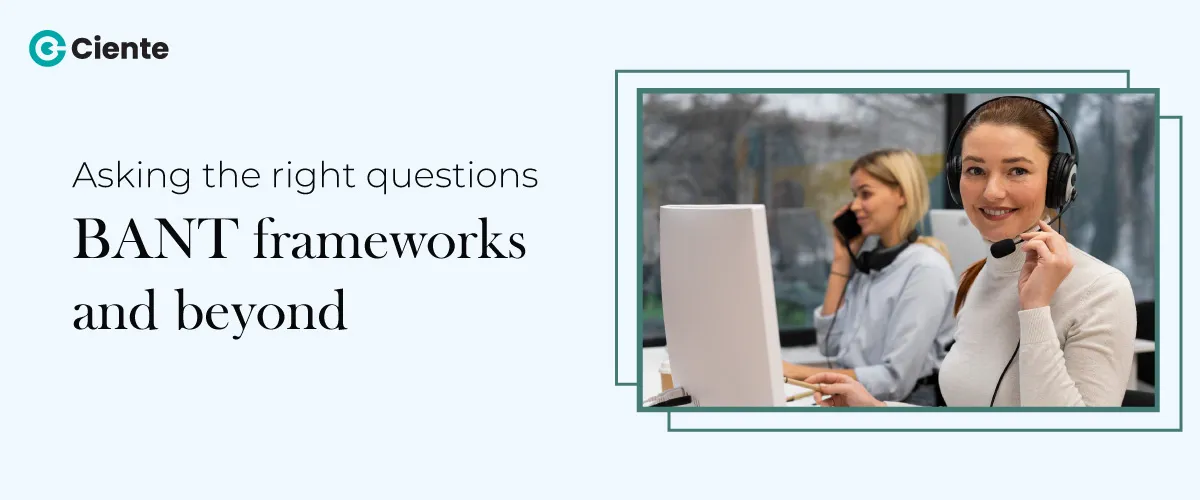A Lead Scoring Model : A Complete Guide
Modern marketing and sales have discovered their treasure trove – data. How can they gauge its maximum potential to find the best prospects?
There’s a fundamental problem with traditional lead-gen strategies.
Imagine a scenario where marketing teams capture leads, collate the details, and hand the list to sales. Sales teams are then expected to call these leads and gauge their intent.
This method of lead generation is counterproductive. It could prove detrimental to sales productivity, and consequently, the irrelevant leads overshadow the high-quality ones.
Lead scoring is your savior in this case.
What is lead scoring?
According to Gartner’s sales glossary, lead scoring has a straightforward definition:
“It’s a method of evaluating the quality of sales leads by using a relative and objective ranking of one lead against another based on a variety of buyer profile fit and behavior criteria.”
This model of differentiating or identifying high-value leads has become an asset for digital marketers. It has also proved to be a bridge between the marketing and sales disconnect, facilitating them to outline integrated efforts.
Adopting lead scoring models can significantly lessen conflict between the two teams, elevating overall performance. Thus, it has become crucial in fast-paced digital marketing.
However, before we dive into the nitty-gritty of lead scoring, let’s underscore why it’s necessary in the first place.
Lead scoring is a vital segment of marketing and sales.
For robust marketing, churning out new (hot) leads, nurturing them, and sending sales-ready leads to the SDRs are paramount. Most marketing strategies, such as lead generation, focus on this. Even after the meticulous execution of these strategies, these concerns persist.
One crucial concern for marketing has always been getting new leads into the funnel.
Beyond these, more challenges are branching from this specific concern:
- Modern buyers interact with your brands across multiple channels and touchpoints. This could easily create complexity in attributing which specific touchpoint drove genuine interest for the prospect.
Why is this a problem? Without this clarity, your teams may either overvalue or undervalue the leads using the incomplete data. And this could further complicate nurturing and scoring efforts.
- Tracking genuine buying signals is tricky. And can result in a lot of ambiguity around an account. Like, a lead might visit your website a couple of times and even download your whitepapers.
But this doesn’t always indicate the intent to buy; they might just be here for market research.
What does this pose a challenge? Most teams cannot fine-tune behavioral data to gauge purchasing intent, or even interpret these signals accurately. This could lead to false negatives and positives in the pipeline.
- Not all leads convert or drop off; some merely go cold. It’s tasking to underline whether these leads have moved on entirely, or the investment into re-engagement campaigns could be worth it.
Should your teams push and dig deeper? Because a lack of these efforts could easily make you lose out on a potential reactivation. The singular means is to attain a nuanced understanding and regular tweaking.
It’s the obvious truth that not every lead is interested in buying from a business.
To relieve themselves of these concerns, marketing teams have moved to adopt strategic lead scoring frameworks.
A glimpse into the basics of lead scoring: Why has it become requisite?
In simple words, lead scoring is an effective means of measuring lead quality.
Imagine lead as a crucial ingredient in a recipe, much like salt. They are a significant portion of the targeted market segment and illustrate interest in a brand.
Irrespective of whether these signals come from new prospects or existing customers, brands contribute a significant portion of their time and resources in nurturing them to:
- Either turn the new prospects into first-time buyers
- Or, convert the existing ones into long-term loyal customers by persuading them to purchase a second time.
Both contribute to a consistent flow of leads in the sales pipeline.
The actual problem lies with lead identification – it’s not this straightforward.
Lead identification isn’t this simple, especially where each lead is characteristically unique. They present multiple attributes that determine whether the particular lead is the ideal fit for a business.
On the one hand, a specific set of attributes illustrates whether they fit a brand’s ICP, and the other outlines how active the leads are and their interest level:
- Personal details: The prospect’s location, industry, job, company size, etc.
- Brand-related actions: The number of pages visited, searches performed on the website, resources downloaded, email click-throughs, demo requests, etc.
This is why data selection is significant in lead scoring.
Of course, such specifics hold different levels of weight for numerous businesses. It highly depends on the company’s working formula and goals – each of them has its own models for assigning scores based on its value system.
However, some common data points are integral in establishing a lead-scoring model and ensuring its effectiveness.
The primary factor is outlining which data should count and which shouldn’t. Because lead scoring isn’t subjective, it’s an analytical approach – the more accurate the assigned score is, the easier it is to discern the most promising leads.
But assigning scores isn’t a piece of cake.
There’s a cluster of data available. But it’s all intertwined and complex to uncoil.
While data is a goldmine for marketers, not every minute facet actually holds any value. This is why it’s paramount for marketers to differentiate which lead information will help lock leads and guide them closer to becoming potential customers.
The 80/20 rule and why it’s a prerequisite for effective lead scoring.
While assigning scores based on historical data sounds easy, the knot of leads and the current business model may complicate it in the flick of a hand. A recent report on sales states that average B2B sales cycles have become 25% longer than before.
With sales turning digital and buyers becoming tech-savvy, selling and buying have become demanding. So, marketing and sales must move. They should leverage leads with the maximum chances of closing.
As the B2B sales expert and an advisory council member of HBR, Mark Osborne states–
“Remember the 80/20 rule: 80% of your revenues come from just 20% of your clients. This is even more pronounced when expanded to the percentage of leads that become your best clients.”
It’s crucial to adapt to the times. So, it might not be a stretch to say that brands that leverage the “see-what-sticks” rule are losing opportunities.
Lead scoring realigns your brand’s priorities.
With a robust scoring strategy, marketers can amalgamate promising leads. It helps rank leads based on their sales readiness.
What are the particular aspects that are considered to rank leads? – their place in the buying cycle, interest illustrated through specific actions, personal attributes, and whether they’re an ideal fit for the company.
However, a lead scoring system isn’t meant for all.
Fundamental limitations and requirements for strategic lead scoring
For businesses with standalone marketing processes, those ignoring the lead database except for hot leads and searching for a quick fix aren’t the ones for whom lead scoring could prove effective.
Lead scoring requires focus and sales input to identify the perfect lead. It’s a long-term strategy that works when modified to the business’s working models. Hence, it’s not merely a superglue that will disperse all lead generation and qualification concerns in one go. The effectiveness might take time.
The same goes for ignoring the entire database except for hot leads. Cold and warm leads still carry intent, even if it’s not as high as the hot ones. This is why nurturing is also a crucial facet of marketing.
Just because a lead shows minimal interest doesn’t mean it cannot be nurtured. Time and resources are significant, and directing these to subpar-quality leads is potentially a waste of time.
But is this always the case? Not quite.
High-intent leads are significant and should be prioritized, but low-intent ones aren’t entirely irrelevant. Meanwhile, some leads can be handed over to sales, and others can be nurtured further rather than ignored.
Lead Scoring: Where’s the real focus?
Lead scoring spotlights all the leads in the database – cold, warm, and hot.
Every integral sales pipeline activity is at the center rather than only the leads. Overall, lead scoring fosters meaningful and relevant conversations. This is crucial for developing interest, irrespective of the intent they hold initially.
Lead scoring has specific intentions – to make marketing more convenient for marketers and offer relevant experiences to the leads. This boosts conversion rates, allowing teams to work more efficiently and speed up sales.
Common lead scoring methodologies: from BANT to data types
One of the common lead-scoring tactics has always been BANT – budget, authority, need, and timeline- used by almost every business at some point.
This is a conventional approach to lead scoring where marketing automation software plays a crucial role. This methodology leveraged two types of information to assign scores:
- Implicit: Form fill-ups, website visits, email click-throughs, and other online behaviors.
- Explicit: Revenue, company size, industry type, job title, etc.
However, there’s another type of data which should be accounted for – spam.
Junk or fake data is always clustered with the essential ones, especially on a company’s landing pages and forms. This data type should be negatively scored or filtered out to ensure that the lead-scoring model is working effectively.
Moreover, a strategic merger of implicit and explicit information can foster a comprehensive angle to a brand’s lead-scoring tactics.
One of them is implicit lead scoring.
Implicit (behavioral) lead scoring
Implicit lead scoring entails behavioral scoring. It tracks a prospect’s online actions to evaluate their intensity of interest in an offering. It also involves scoring leads on the quality of data marketers hold, such as the location of their IP addresses.
Behavioral scoring, like any scoring model, gauges the prospect’s intent to buy. Behaviors such as responding to emails, whitepaper downloads, website interaction, and getting back on offers demonstrate high interest.
However, online behaviors aren’t easy to determine – they are multidimensional and ambiguous. So, a scoring system can be outlined based on two behaviors – passive and active. Passive behavior indicates a low engagement rate, whereas active buyer behavior means hot leads demonstrating high engagement.
Examples of implicit lead scoring –
Imagine one prospect visiting a brand’s website, downloading a whitepaper and eBook, and signing up for its newsletter. Whereas the second one likes and shares the same brand’s LinkedIn post, clicks on a link, and browses the website. But they don’t take any further action.
Even though both prospects engage with the brand, their behaviors carry different weight. Lead scoring has to take this into account, too. The first prospect might actually be interested in the brand’s solution if they download “how-tos” and significant resources.
However, the second one might require nurturing, i.e., more persuasion into how the brand’s solution is right for them. But even for the nurturing process, qualifying them as fitting the target market is crucial. Or the efforts are truly wasted.
Sometimes, a lead-scoring model might assign the same score to active and passive prospects.
So, what’s the solution here?
Evaluating the total score against the score from the last few months. Using certain flags to mark more active actions or assigning different scores for distinct products.
This lead scoring depends on the information the marketing teams collate through marketing automation software and tools.
However, there’s another means – leveraging data that prospects offer.
This is explicit lead scoring.
Explicit lead scoring
The data for this lead-scoring process comes through registrations, form fill-ups, newsletter signups, etc. It entails demographic and firmographic data outlining how well the prospect fits the brand’s ICP and if it aligns with the buyer persona.
Some of the most common data that marketers should consider are job title, company size, industry, revenue, and geographical location.
With explicit lead scoring, it’s straightforward to deduct scores, too. When a prospect unsubscribes from the newsletter or emails, has an entry-level job, or shows no interest in adopting new services.
Sometimes, this prospect data also relays how well they fit the ICP. But it’s more prominently used to attribute negative scores or deduct them. Data-based scoring is quite a simple lead-scoring method. Including this with the existing lead scoring model can elevate the comprehensiveness of the process.
This is highly beneficial to:
- Enhance communication quality
- Scale marketing efforts
- Help map a complete prospect profile
But one lead-scoring model might not be enough.
As a business scales, it might expand its service line while entering new markets. So, a one-size-fits-all lead-scoring model wouldn’t suffice.
Comprehensively assigning scores focuses on both implicit and explicit methodologies. It tracks whether the prospect rightly fits and has the relevant interest.
By developing a model that prioritizes both these attributes, it’s easier to highlight prospects with high scores in both categories and demonstrate quite a high conversion potential.
Additional lead scoring models to find the right fit for your business.
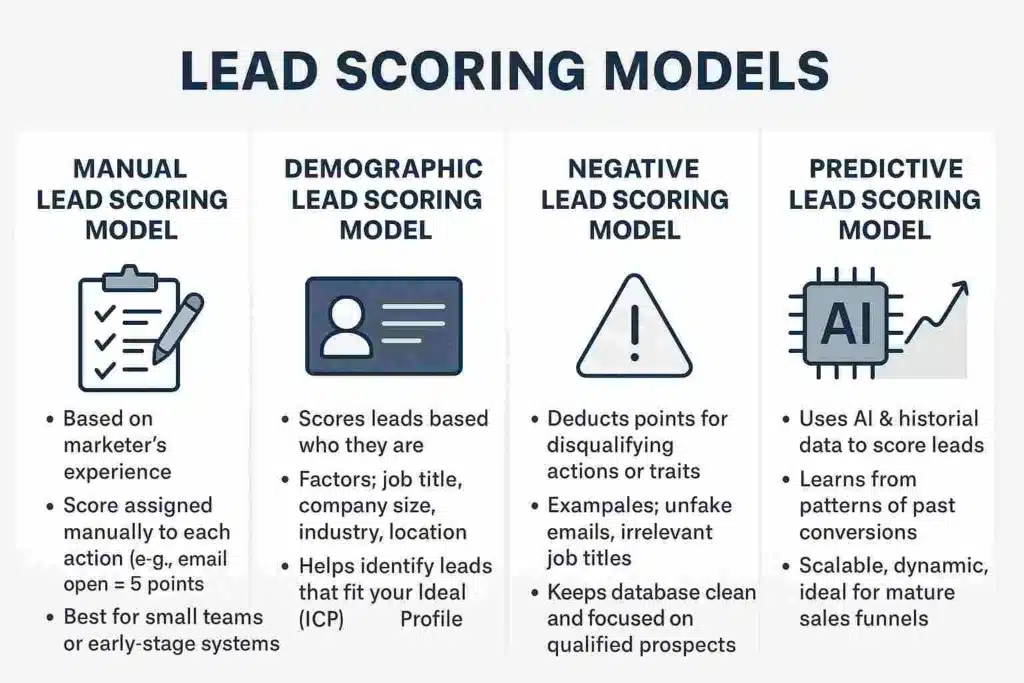
1. Manual lead scoring model
In a manual lead-scoring model, marketers assign lead scores based on their experiences and judgment. Most often, this is also based on some qualitative data, not pre-set rules or algorithms.
How does this model work?
Typically, your SDRs or marketers evaluate each lead using a checklist, attributing how valuable or sales-ready they truly are.
But there are more nuances –
1. The primary step in lead scoring is setting a benchmark.
To highlight this, analyze the newly acquired customers against the total number of generated leads. This is the lead-to-customer conversion rate and gives your brand a measurable objective.
2. Second, underline and select the different attributes of leads you think were high-value ones. Not every available criterion can be used for the lead scoring model. It should align with the sales objectives and fit the current business model.
The chosen attributes depend on having detailed conversations with sales and what truly matters to your brand.
3. Third, evaluate the closing rate for each attribute. This underscores the marketing team’s actions while figuring out how many people convert based on their actions.
4. Lastly, compare the close rate of individual attributes with the overall sales team closing rate.
In manual lead scoring, points are assigned from 1 to 100 based on the outlined data types. In the final evaluation, the points are then added – the higher the final score, the more likely the lead is to convert.
The overall process of assigning scores is somewhat linear –

However, manual lead scoring has two limitations: it’s laborious and prone to human error. This traditional process is based on salespeople’s historical experiences and “gut feeling.” It decreases the accuracy of the entire model, allowing hot leads to fall through the cracks.
2. Demographic lead scoring model
The demographic lead scoring model is based on the aspect of ICPs, from job titles to industry size. It considers not merely who the leads are but also what they do.
But this model has an inherent complication: there are several demographic traits, so it’s crucial to gauge how they interplay and evolve.
Think: a fintech company’s marketing manager may score differently than a retail business’s CMO. The buying stages, needs, and budgets are obviously different – one size doesn’t fit all.
Demographic traits are static, but the overall lead scoring model can’t depend on these immobile numbers. It also has to gauge the fluidity of businesses and the marketplace – how quickly they pivot. The industry shifts every three years, titles change, and goals meander.
Without consistent updates to the collated data and proper data hygiene, your lead scoring methods are outdated. The leads that once fit and were deemed relevant might not be anymore.
This is a crucial aspect to factor in to avoid wasted efforts and resources.
But this lead scoring model has a significant limitation: it heavily relies on demographics. By only focusing on these traits, your business can overlook emerging segments or unconventional buyers who don’t fit in but hold genuine interest.
This could lead to several prospective opportunities just slipping through the cracks.
While the demographic lead scoring model is optimized to filter the right fits, it could potentially blindside teams. Especially when detached from the behavioral context. The framework you follow here shouldn’t be too rigid and should be streamlined to find a balance.
A balanced framework: coupling demographical statistics with real-time engagement insights.
3. Negative lead scoring model
Negative lead scoring is quite a subtle but highly underappreciated segment of lead qualification.
There’s one thing every marketer must understand: not all leads are relevant and worth pursuing. While some undertake spammy actions, others are not interested and actively detract from any interaction.
In this model, you deduct scores/points when leads portray low-intent behavior. It asserts that not every click is a green light, something most marketers often forget. A lead could be interacting with content that has nothing to do with buying your solutions – zilch, not the slightest interest in your brand.
While some others may illustrate a decline in interest, such as unsubscribing to your newsletter, unfollowing you on social media, or downloading reports for academic purposes.
Negative lead scoring takes these behaviors into account. It ascertains that your teams aren’t spending time than required on leads that showcase unfavorable actions, especially to avoid lead score inflation.
Overall, this model works for two scenarios: to remove non-prospects and streamline the scale for leads with unfavorable attributes.
So, the focus is solely directed towards nurturing high-quality leads.
Deducting points is as necessary as adding them. It identifies the non-prospects amidst a pool of potential ones, saving your time. You’re deprioritizing irrelevant leads quite early on and cleaning your sales pipeline. This is a strategic step to:
- Avoid misleading and inaccurate metrics
- Wasting resources on leads that you know won’t convert
- Adjust messaging only for nurturing high-priority leads
- Elevate overall sales performance and efficiency
4. Predictive lead scoring model
Lead-scoring has now shifted to predictive lead-scoring.
Even though the purpose remains etched in stone, the tidbits have significantly evolved. Today, modern marketers leverage the prowess of AI and machine learning to predict high-quality leads.
Adopting predictive lead scoring is imperative across today’s dynamic business landscape.
Developing a model is just not enough. Tweaking it regularly to ensure its accuracy is crucial.
But what if your team doesn’t have to do that anymore? Technology has made this convenient.
Predictive lead scoring utilizes machine learning capabilities to sort through thousands of data points and highlight the best lead. It assigns scores using predictive modeling algorithms.
How does predictive lead scoring work?
Predictive lead scoring is a step ahead. It leverages implicit, explicit, and historical data.
In the initial phase, the business integrates predictive lead-scoring software like HubSpot with its CRM. This allows the software’s machine learning capabilities to assess the data points across the business’s contact base and discover the perfect leads for conversion.
It studies the website and email behaviors, interactions logged in the CRM, and demographic and firmographic data to identify the leads. The software sifts through data from multiple sources, offers real-time insights, and reroutes the high-scoring leads to the sales reps.
Overall, in predictive scoring, the model looks at the information that customers have in common and those who closed but didn’t have anything in common. This is developed into a formula where prospects are sorted, beginning with those with the highest potential to convert.
Technically, it automates the entire manual process. The advantage is that it’s scalable, effectively expanding the business’s database, leads in the pipeline, and sales team.
Another benefit is how the software improves itself as it gains more data from the leads. The machine gets intelligent as it works and collates data points, and the lead-scoring strategy automatically streamlines and optimizes as required.
Lead scoring best practices.
To effectively qualify leads that truly align with your business requirements, you need the best practices.
The focus shouldn’t be merely on data. Of course, data is a goldmine, and integrating predictive lead scoring is all about convenience. However, such processes require a lot more than this.
Lead scoring best practices aren’t about setting up a machine and letting it do its job. Marketing and sales still have to lend a helping hand.
And even if that’s not necessary, the teams must understand how this process aligns with their lead-nurturing roadmaps.

1. Understand what led a customer to start as a lead or even make a purchase. Highlight the analytical information and map how it slowly transforms at each marketing funnel stage – what made an impression on the prospect?
2. Leverage the sales teams’ insights and experience. They are adept at reading the audience and are the ones who interact with them.
By outlining their buying behavior, your teams could identify which campaigns have the most influence. This will allow marketing to refine the leads’ exposure to key information and content.
3. Hearing from the buyers themselves can never go wrong. It’s advantageous to hear from those who use the services to underscore the whys. Their perspective can offer enormous value to the sales and marketing processes.
Why did they make a purchase? Map out the patterns in the buying behavior of different clients.
4. Prioritize the prospect data available. Predictive lead scoring is objective. The data it collates might not entirely be incorrect. At least 80% of it might highlight the prospect’s interest.
So why not leverage this? Only particular trial and error can help understand whether it’s working as it should.
5. But data isn’t always the champion. Sometimes, inauthentic or even stale data can create problems while initiating contact with prospects. The conventional approaches don’t consider market trends, the industry’s shifting dynamics, or inconsistent buyer behavior.
To stay ahead of the revenue curve, implement real-time adjustments.
In reality, lead scoring is a mix of observable and immeasurable components.
Assigning scores isn’t merely about attributing numbers to prospects. As outlined beforehand, the nitty-gritty of scoring must be understood comprehensively.
Truthfully, predictive scoring models have taken the labor off marketers’ and SDRs’ hands. But their role in the process hasn’t been entirely diminished; only their labor has. A strategic and robust lead-scoring demands an alignment between marketing and sales.
Any disjointedness will only create issues further down the pipeline. What good is a contact list of hot leads if marketing and sales don’t even see eye to eye on what a “lead” means?
Further down, how will anyone establish who are quality leads and who aren’t?
When the point scoring system isn’t aligned and based on a shared vision, how can it be expected to give the desired results?
The sales pipeline could get leads who aren’t interested in a purchase.
What sense does quantity make without any quality?
Marketing and sales both bring unique insights to the lead-scoring process. Before any other step, lead scoring best practices ensure a synergy between marketing and sales.
This will build a high-quality pipeline and ensure leads convert on time, resulting in a boost in revenue stream for a long time to come.

